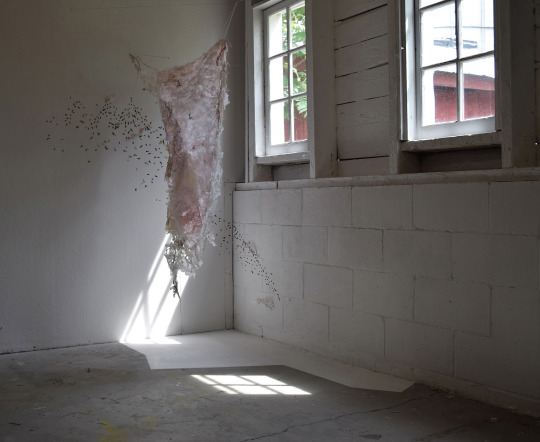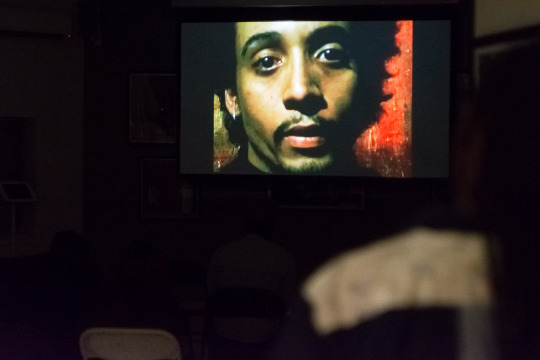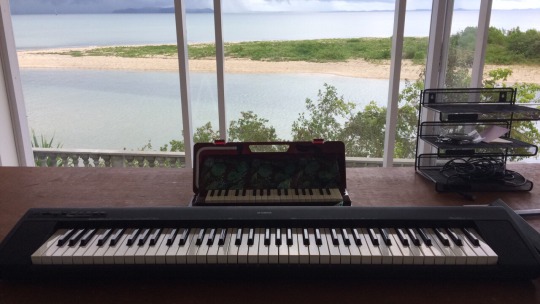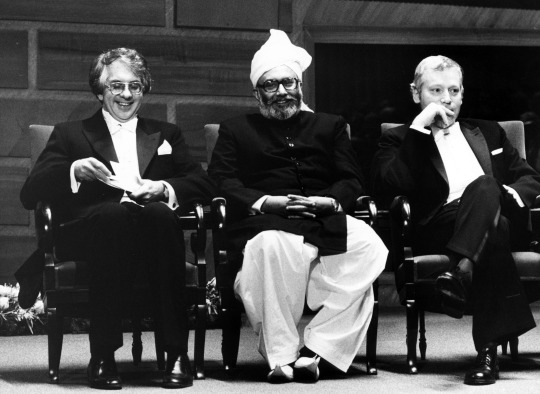#roya amigh
Explore tagged Tumblr posts
Text

roya amigh
http://www.royaamigh.com/collision-response/
74 notes
·
View notes
Photo

Throw Back Thursday to Art-in-Buildings' 2016 exhibition, Roya Amigh: The Abrasion at the West 10th Window!

Roya Amigh's The Abrasion is an abstract representation of a survivor of assault, suspended in space by thread as a mass of paper and glue. Like the violence imposed upon the body of a survivor, Amigh agitates the surface of the paper with scissors to produce rough marks and create a sense of flesh. Amigh then tears the paper into smaller pieces and reconstructs them with glue to create two white, translucent surfaces, or skins, that are finally bound together with a strip of pink lace. Formally, Amigh treats her paper with different types of glue to create varied textures and shades of white, while the delicate object hangs, almost weightlessly, suspended from the ceiling. Metaphorically, Amigh's process represents the victim's desire to no longer inhabit her body and to leave it behind after a sexually abusive experience.

Born in Tehran, Roya Amigh grew up with Persian mythology heard in stories told by her uncle. Persian storytelling does not follow a linear structure, and is typically told by narration from one person to another. The line of narration can go on and on, from person to person and recounting to recounting, inevitably creating stories within stories and fictions within fictions. Echoing the natural distortions of memory, Amigh creates her own version of this mythology in her practice, featuring stories that happened to her or to the women she knows. The delicacy of her objects reflects the ephemeral quality of a memory suspended in space. This fragility, the violence imposed upon the medium, and the ways in which Amigh mimics the desires of the victims she evokes is her own creation of a new, visual Persian mythology.

Learn more on the Art-in-Buildings website!

#Art-in-buildings#artinbuildings#aib#roya amigh#west 10th window#w10w#public art#art nyc#sculpture#installation#iranian artist#contemporary art#window art#west village art
0 notes
Text
Year in Review | Fiscal Sponsorship in 2018

To wrap up what has been an eventful year, NYFA is commemorating our artists’ blossoming achievements!
NYFA Fiscal Sponsorship is proud to support these projects by helping them fundraise and bring their work to wider audiences. Here are a few highlights from this past year:

Monika Fabijanska THE UN-HEROIC ACT: Representations of Rape in Contemporary Women’s Art in the U.S.
In September, art historian and curator, Monika Fabijanska, launched the impactful exhibition, THE UN-HEROIC ACT: Representations of Rape in Contemporary Women’s Art in the U.S., at John Jay College of Criminal Justice. Fabijanska’s vision for the curated exhibition was sparked by seeing Carole Thea’s Sabine Woman sculpture in 2015. The exhibition was a milestone not only for female artists who aim to dismantle the romantic representations of rape in the media, but also for survivors whose voices and perspectives have been left out in contemporary art. The New York Times featured THE UN-HEROIC ACT as an exhibition in which “female artists delete rape’s ‘heroic’ underpinnings.”

The Luminal Theater
Founded by Curtis John, The Luminal Theater is a microcinema based in Central Brooklyn which provides a platform for filmmakers and film enthusiasts who exhibit media of the African diaspora. The Luminal Theater has catered to their growing audiences by screening films from emerging filmmakers and film enthusiasts through their Cinema Garden Parties and special film screening events. In June, The Luminal Theater’s short films Kafou and Tezen were shown at the Brooklyn Academy of Music as part of BAM’s Caribbean Film Series event. The organization also co-hosted Selebrasyon!, a film festival celebrating film made by the Caribbean diaspora, with Haiti Cultural Exchange, Caribbean Film Academy, and Hudson Guild. The Luminal Theater was awarded a 2018 NYSCA Grant.

Deanna Witkowski Nossa Senhora Suite
Pianist and Composer Deanna Witkowski has had a jam-packed year with Nossa Senhora Suite, a musical project which fuses Afro-Brazilian ritual music and jazz. The idea for Nossa Senhora Suite grew from Witkowski’s first visit to Brazil in 2006, where she returned as a performer in 2007 and 2010. Witkowski was selected as a 2018 NYSCA individual artist grant recipient and was also awarded a residency fellowship at the Sacatar Institute in Itaparica, Bahia, Brazil, where she met fellow pianists, held workshops, and continued doing research for Nossa Senhora Suite. Witkowski’s next performance is on Saturday, December 8 at The Hillman Center in Pittsburgh, PA.

Zakir Thaver Salam - The First ****** Nobel Laureate
After a decade of research and compilation, Zakir Thaver premiered the documentary film Salam - The First ****** Nobel Laureate to audiences in the U.S. and abroad. The documentary follows the history of Nobel Prize-winning Pakistani Physicist Abdus Salam, who made a profound impact on modern science but who was shunned in his home country because of his religion. In 2018, Salam has managed to snag a plethora of awards and official selections from the Raw Science Film Festival, Washington, D.C. to Chicago’s South Asian Film Festival, and the Human Rights Film Festival, to name a few. The next screening of Salam will be on Saturday, December 15 at The South Asian International Film Festival in the NYIT Auditorium on Broadway in New York City.

Roger Grunwald The Obligation
Internationally-acclaimed actor Roger Grunwald premiered his one-man performance The Obligation at Potrero Stage in San Francisco, CA. The story follows the life of a Polish Jew living in Bialystok during World War II. The Obligation was a 2018 Theater Bay Awards Finalist for Outstanding Solo Production, Outstanding Lighting Design, and Outstanding Sound Design. Broadway World called Grunwald’s performance “a thoroughly compelling, thrilling experience.”
- Eleysha Sajous, Fiscal Sponsorship Intern
NYFA Fiscal Sponsorship’s next quarterly no-fee application deadlines are December 31, March 31, June 30, and September 30, with out-of-cycle reviews accepted year-round. You can learn more about NYFA’s Fiscal Sponsorship program here.
Images From Top: The Obligation, Courtesy of Roger Grunwald; The Coerced Contact, Roya Amigh, Courtesy of Monika Fabijanska; Act of Protest, Courtesy of The Luminal Theater; Sacatar Institute in Brazil, Courtesy of Deanna Witkowski; Abdus Salam, Courtesy of Zakir Thaver; The Obligation, Courtesy of Roger Grunwald.
#nyfa fiscal sponsorship#fiscal sponsorship#eleysha sajous#artist news#roger grunwald#the obligation#zakir thaver#salam#abdus salam#deanna witkowski#nossa senhora suite#curtis john#the luminal theater#monika fabijanska#the un-heroic act#instagram
4 notes
·
View notes
Photo

I’ll be speaking today with some of my favorite artists and thinkers @shivagallery.art Please come join the conversation if you’re in the neighborhood. ————————————Join us for the gallery tour of „The Un-Heroic Act” and artist talk with the great Lynn Hershman Leeson, Angela Fraleigh and Roya Amigh, on what means artists employ to tell personal stories. Lynn Hershman Leeson’s Electronic Diary Part III: First Person Plural, 1988, will be screened as part of the event. Wednesday, October 24, 2018, 6-8 PM @shivagallery.art The New York Times review of the show linked in the bio. ARTISTS @yokoonoofficial #anamendieta @suzanne.lacy #senganengudi @lynn_leeson @cthea106 @guerrillagirls #jennyholzer @kathleengilje @angelafraleigh @nataliegwenfrank @jennifer_karady #sonyakellihercombs @radicalhospitality @adaluisatrillo @kara_walker_official @royaamigh @naimaramchap #banggeulhan @guerrillagirlsbroadband #unheroicact #iconographyofrape #rapeexhibition #stoprape #endviolenceagainstwomen #metoomovement #feministart @bridgetdonahue.nyc (at The Anya and Andrew Shiva Gallery & President's Gallery) https://www.instagram.com/p/BpUkOapFX-9/?utm_source=ig_tumblr_share&igshid=4ndtj1az6rao
#anamendieta#senganengudi#jennyholzer#sonyakellihercombs#banggeulhan#unheroicact#iconographyofrape#rapeexhibition#stoprape#endviolenceagainstwomen#metoomovement#feministart
0 notes
Text
Hyperallergic: How to Create a Butterfly
Installation View of Roya Amigh’s In my sleep I migrate back with “Back and Forth” (2017, left) thread, pieces of cloth and paper, 49 x 62 in; and “The world is that kind of sleep” (2017, right) dandelions and pieces of cloth, 25 x 25 x 62 in (all photos by the author for Hyperallergic)
In “Silent Diary” (2013–17), one piece of Roya Amigh’s exhibition In my sleep I migrate back at Five Myles in Crown Heights, Brooklyn, thin, black thread affixed to a small, oddly shaped skein of paper arrayed on top of a gray block reads: “How does a caterpillar arrange itself into a butterfly?” This is the question that pulls me through the entire show. Amigh’s creations consist of glued sheets of lace, dandelions, cardboard, and translucent, handmade paper that’s distressed, shredded or cut, with bits of thread glued on to form words or figures. She fabricates an answer to this central question by using particular combinations of thread and configurations of the hybridized paper to demonstrate how simple materials can metamorphose into storytelling.
Installation view of Roya Amigh’s In my sleep I migrate back, with “Silent diary” (2013–17, center) thread, paper and dandelions, 17 x 11 x 25 in
When Amigh uses the black thread to spell out letters, words, and phrases, the ensuing story makes me recall the literary strategy of using snippets of dialogue and news headlines to give the reader the requisite clues to piece together the nature of the world in which the characters operate — as one might do with a Jeffrey Eugenides novel. Here, with “Looming Danger” (2017), it’s a tale of contemporary American xenophobia. I read: “Kansas town reels months after failed mosque bombing; Pending a review of our procedures for screening refugees; hate crime …” It doesn’t fail to amaze me that the headlines remain the same as they were five, ten, or twenty years ago, and yet the response is frequently frenzied fear — as if historical amnesia is our default setting.
When Amigh uses the black thread to form shapes and figures, I find a much looser narrative — really I only make out characters and settings. In “Back and Forth” (2017), I can tell the setting is west Asia because there are many camels, and lambs, as well as horses, plus angels with bird-like wings attached to their scapula, and men wearing turbans that curve near the top. Amigh might be depicting a fairy tale, a legend, family history (she is from Iran), or a dream. I cannot tell, but the ancient technique of creating pictograms has been a means of storytelling for millennia, and here it feels like Amigh is simultaneously letting me glimpse her personal history and a collective one. From the exhibition press release I gather that she is using the writings of the Persian poets Ferdowki, Rumi, and Hafez, and Persian legends, but still, she might have given me more to go on.
Detail of Roya Amigh’s “Back and Forth” (2017)
Lastly, Amigh moves the viewer through meaning by creating shapes that are themselves visual puzzles and bric-a-brac such as the collection of bits and pieces that come to resemble a wasps’ nest in “There is an inner wakefulness that directs the dream” (2017). These magpie fabrications are the least compelling for me because it feels like the pieces yield the urgency that impelled their creation to the seduction of formalist matters. The story those works tell is of their own relentless making, a menagerie of strange bits and pieces like a dying flower erupted. The exhibition seems to me in this last piece to exist in that larval stage and in the others to have already sprouted its wings.
Roya Amigh’s In my sleep I migrate back, continues at Five Myles (558 St. Johns Place, Crown Heights, Brooklyn) through August 27.
The post How to Create a Butterfly appeared first on Hyperallergic.
from Hyperallergic http://ift.tt/2velEJg via IFTTT
0 notes
Text
Get to Know: Roya Amigh

Interviewed by: Eliana Blechman
We asked Roya Amigh a few questions about her practice, her choice of materials, and the influence of Persian mythology on her work. Read on for more...
Art-in-Buildings: The Abrasion deals with a very dark subject matter, acting as an abstract representation of a survivor of assault, while your chosen materials are very light and airy with calm and quiet colors. How did this contrast in subject and medium come about?
Roya Amigh: The delicacy of my work with translucent papers and minute stitchery-like forms embodies my exploration of memory and its manifestation through layered scenes referencing bits of historical Persian storytelling. Using basic, easily accessed materials such as paper, glue, scraps of fabric or lace and colored threads leads me to chronicle lingering contemporary issues. "Abrasion", is an abstract commentary on abuse. This installation consists of delicately entwined pieces of stories on papers and lace strung en masse throughout the window that reveal fragile and often ephemeral reflections of forlorn memory.
AiB: How does Persian mythology influence your practice?
RA: My method of pairing present day issues of concern with selections of historical storytelling allows me to create my own mythologies that address societal problems of today.
I incorporate symbols from mythology that include beings such as Huma, Dragon, and Daeva as they appear in the writings of the Persian poets Rumi, Ferdowsi, and Hafez. For instance, in my work, Huma becomes a metaphor of the female and represents the strength of women to go beyond all the limitations, since she never lands and flies invisibly high above the earth, impossible to spot through the human eyes. According to Sufi lore, Huma represents the evolution of a thought to the zenith where it breaks all limitations.

AiB: How did the limited space of the West 10th Window impact your work?
RA: The interior of the West 10th Window space was an exceptional opportunity for me to create the spatial and mystical qualities considering shadow and light with each other.
I was particularly intrigued by the elements of light, shadow and material for this project. Using lightweight materials to create the spatial qualities and application of shadow and light with each other gives a mystical sense of the space strain between the West 10th Window's walls and floor as though paralyzed by female trauma. The triangle dark pieces of cloth resemble a flock, which is emphasized by the light that gives a dynamic quality to the form.
AiB: Though largely contained within the West 10th Window, there are a few points at which the materials extend outside of the confines of the window (the small black triangles stuck onto the outside of the window). What is the intention behind this subtle gesture?
RA: I am interested in creating moments, which despite being almost invisible have an essential role in transferring the work into a new physical space. By doing so, I invite my audience to first engage with my work visually and then through productive conversations.

AiB: What's next for you?
RA: I am building a new body of work for two upcoming solo shows – one in Lincoln, NB, and the other in Brooklyn, a few group shows in NY and MA, as well as preparing for a discussion panel and bookbinding workshop in The Art Complex Museum in Duxbury, MA, 2017.
Learn more about Roya Amigh on her website!
To stay up to date on Time Equities Art-in-Buildings Projects, subscribe to the blog, visit our facebook, and connect with us on twitter and instagram!
#art in buildings#Roya Amigh#artist interview#public art#west 10th window#w10w#west village#art nyc#art installation#Iranian artist#Persian mythology#mythology#paper art
3 notes
·
View notes
Photo


Thank you to all who have helped us along the way, especially all of our exhibiting artists. Roya Amigh | Inna Babaeva | Jarrod Beck | Jesus Benavente | Patrick Bérubé | Cristina Camacho | Matt Chalker | Lauren Clay | Caitlin Cocco | Pam Council | Heather Cox | Blue Curry | Cui Fei | Doreen Garner | Sara Gassmann | Kirsten Hassenfeld | Daniel Horowitz | Melissa Jordan | Kakyoung Lee | Forrest Lewinger | Liliya Lifanova | Kristin McIver | Amanda Millet-Sorsa | Marilyn Minter | Martha Mysko | Dominique Paul | Gustavo Prado | Alan Ruiz | Carol Salmanson | Greg Smith | Ivan Stojakovic | Jessica Stoller | R. Blair Sullivan | Patrice Renee Washington



Next up at the w10w: David Stein, Christina Watka, Jeff DeGolier, Zach Wollard, and Robbin Deyo.
The West 10th Window is curated by Natalie Diaz, Jennie Lamensdorf, and Eliana Blechman and is sponsored by Time Equities, Inc. (TEI) Art-in-Buildings Program. TEI is committed to enriching the experience of our properties through the Art-in-Buildings Program, an innovative approach that brings contemporary art by emerging and mid-career artists to non-traditional exhibition spaces in the interest of promoting artists, expanding the audience for art, and creating a more interesting environment for our building occupants, residents, and their guests.

To stay up to date on Time Equities Art-in-Buildings Projects, subscribe to the blog, visit our facebook, and connect with us on twitter and instagram!
#West 10th Window#public art#art nyc#w10w#art exhibition#art space#roya amigh#inna babaeva#jarrod beck#jesus benavente#patrick berube#cristina camacho#matt chalker#lauren clay#caitlin cocco#pam council#heather cox#blue curry#cui fei#doreen garner#sara gassmann#kirsten hasseneld#daniel horowitz#melissa jordan#kakyoung lee#forrest lewinger#liliya lifanova#kristin mciver#amanda millet-sorsa#marilyn melo
0 notes
Photo

Visit FiveMyles this Friday, 8/25, 6pm for Roya Amigh in conversation with Monika Fabijanska and Haleh Liza!
In conjunction with the exhibition: ROYA AMIGH, IN MY SLEEP I MIGRATE BACK
August 5 - 27, 2017
Thu-Sun, 1-6 PM, or by appointment


0 notes
Photo

This week we’re featuring the amazing artists from all over the world that have exhibited with Art-in-Buildings. We are proud to have worked with these inspiring people. Roya Amigh is an Iranian artist who earned a BFA and MFA in Tehran before completing a Master's in Fine Arts degree in 2012 at Boston University. Roya's work has exhibited throughout Colorado, New York and Massachusetts. She has been attended many Artist-In-Residence programs such as Art Omi, The Millay Colony for the Arts, and Vermont Studio Center. She was a recipient of Vermont Studio Center Fellowship in 2015, Ruth Katzman Scholarship in 2014, and Constantine Alajalov Scholarship in 2010-2012. "I grew up with Persian mythology heard in stories told by my uncle. Persian storytelling does not follow a linear structure, and it is typically told by narration from one person to another. The line of narration can go on and on, from person to person and recounting to recounting, inevitably creating stories within stories and fictions within fictions. Echoing the natural distortions of memory, I create my own version of this mythology in my practice, featuring stories that happened to me or to the women I know. My work investigates the relationship between mindfulness and daydream: how presence of mind meets the imagination to yield a memory. My practice is based on revealing suspended moments of memory in order to realize the uncertain border between meditation and rumination. In some ways, my works resemble set pieces in invented epics. I start by rendering large numbers of small drawings. These drawings consist of lines that appear as if in relief, created by gluing and composing thread on paper. My imagery is based on Persian miniatures. I incorporate symbols from mythology that include beings such as Huma, Dragon, and Daeva as they appear in the writings of the Persian poets Rumi, Ferdowsi, and Hafez. By assembling line drawings, mixed-media such as bark or paper, and the physicality of the environment itself, I create a fragile structure that reflects the ephemeral quality of a memory suspended in space."
Learn more at http://www.royaamigh.com/
0 notes
Photo

So honored to be part of this incredible exhibition curated by @monikafabijanska I’ll be speaking with Monika, Roya Amigh and legendary Lynn Hershman Leeson for a panel discussion on “The Personal Sphere” next Wednesday. Love this photograph by @jennifer_karady Thank you to @jilnotjill and @nytimes Jillian Steinhauer wrote: “The Un-Heroic Act,” in its nuanced way, reflects a world in which sexual violence is simultaneously traumatic and ubiquitous, singular yet commonplace. It demonstrates what art can do so uniquely: move beyond the negotiation of facts to an embrace of deeper truths, and new conversations about them.” Link in the bio. On view @shivagallery.art through Nov. 3, M-F 10-6, Sat 12-6. 🙏🙏🙏 to all the powerful and courageous artists in the show: @yokoonoofficial #anamendieta @suzanne.lacy #senganengudi @lynn_leeson @cthea106 @guerrillagirls #jennyholzer @kathleengilje @angelafraleigh @nataliegwenfrank @jennifer_karady #sonyakellihercombs @radicalhospitality @adaluisatrillo @kara_walker_official @royaamigh @naimaramchap #banggeulhan @guerrillagirlsbroadband #unheroicact #iconographyofrape #rapeexhibition #stoprape #endviolenceagainstwomen #metoomovement #feministart (at The Anya and Andrew Shiva Gallery & President's Gallery) https://www.instagram.com/p/BpHLtuuF3qF/?utm_source=ig_tumblr_share&igshid=19gllb53hccfj
#anamendieta#senganengudi#jennyholzer#sonyakellihercombs#banggeulhan#unheroicact#iconographyofrape#rapeexhibition#stoprape#endviolenceagainstwomen#metoomovement#feministart
0 notes
Text
Now on View: Roya Amigh, The Abrasion

Time Equities Inc. Art-in-Buildings is pleased to announce the newest exhibition at the West 10th Window: Roya Amigh, The Abrasion.
Roya Amigh’s The Abrasion is an abstract representation of a survivor of assault, suspended in space by thread as a mass of paper and glue. Like the violence imposed upon the body of a survivor, Amigh agitates the surface of the paper with scissors to produce rough marks and create a sense of flesh. Amigh then tears the paper into smaller pieces and reconstructs them with glue to create two white, translucent surfaces, or skins, that are finally bound together with a strip of pink lace. Formally, Amigh treats her paper with different types of glue to create varied textures and shades of white, while the delicate object hangs, almost weightlessly, suspended from the ceiling. Metaphorically, Amigh’s process represents the victim’s desire to no longer inhabit her body and to leave it behind after a sexually abusive experience.

Born in Tehran, Roya Amigh grew up with Persian mythology heard in stories told by her uncle. Persian storytelling does not follow a linear structure, and is typically told by narration from one person to another. The line of narration can go on and on, from person to person and recounting to recounting, inevitably creating stories within stories and fictions within fictions. Echoing the natural distortions of memory, Amigh creates her own version of this mythology in her practice, featuring stories that happened to her or to the women she knows. The delicacy of her objects reflects the ephemeral quality of a memory suspended in space. This fragility, the violence imposed upon the medium, and the ways in which Amigh mimics the desires of the victims she evokes is her own creation of a new, visual Persian mythology.

Roya Amigh is an Iranian artist who earned a BFA and MFA in Tehran before completing a Master's in Fine Arts degree in 2012 at Boston University. Roya's work has exhibited throughout Colorado, New York and Massachusetts. She has participated in various residency programs, including Art Omi, The Millay Colony for the Arts, and Vermont Studio Center. She was a recipient of Vermont Studio Center Fellowship in 2015, and Ruth Katzman Scholarship in 2014, and Constantine Alajalov Scholarship in 2010-2012. She is currently living and working in Boston, MA.
Next up at the West 10th Window: Daniel Horowitz, Doreen Garner, and Robbin Deyo.
For press inquiries please contact: Monique Peterson, QUINN | [email protected] | 212.868.1900 x387
The West 10th Street Window is curated by Natalie Diaz and Jennie Lamensdorf and is sponsored by the Time Equities Inc. (TEI) Art-in-Buildings Program. TEI is committed to enriching the experience of our properties through the Art-in-Buildings Program, an innovative approach that brings contemporary art by emerging and mid-career artists to non-traditional exhibition spaces in the interest of promoting artists, expanding the audience for art, and creating a more interesting environment for our building occupants, residents, and their guests.
Learn more about Roya Amigh’s work on her website.
To stay up to date on Time Equities Art-in-Buildings Projects, subscribe to the blog, visit our facebook, and connect with us on twitter and instagram!
#Roya Amigh#west 10th window#w10w#art in buildings#aib#public art#nyc art#art nyc#iranian artist#art installation#west village#paper art
1 note
·
View note